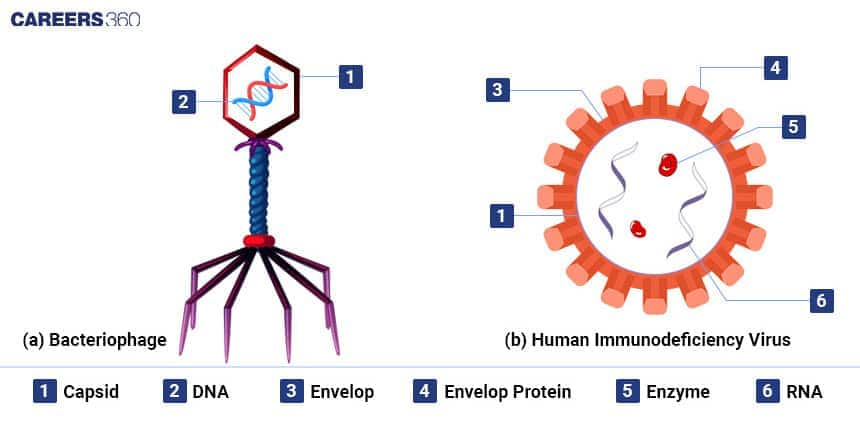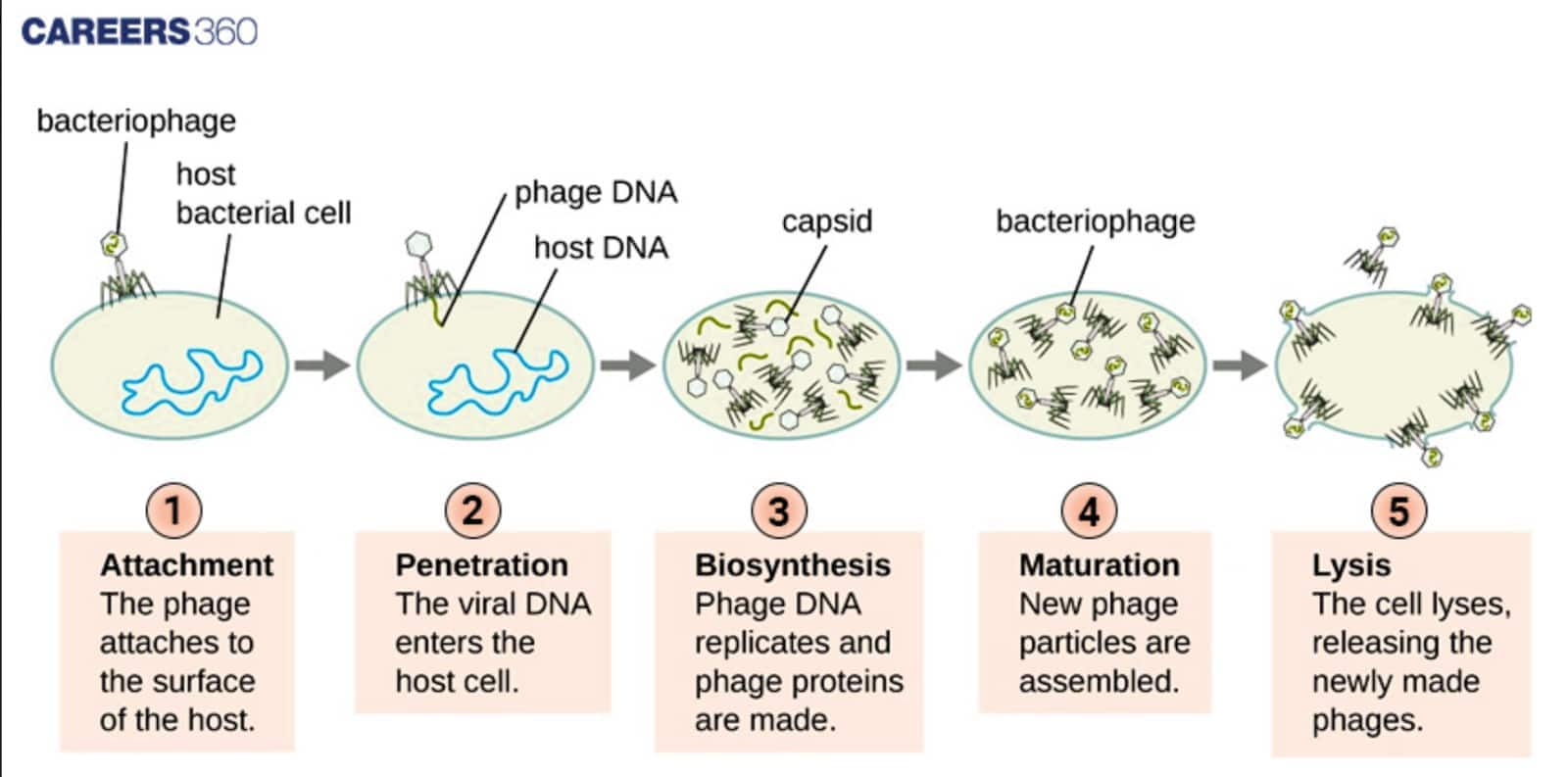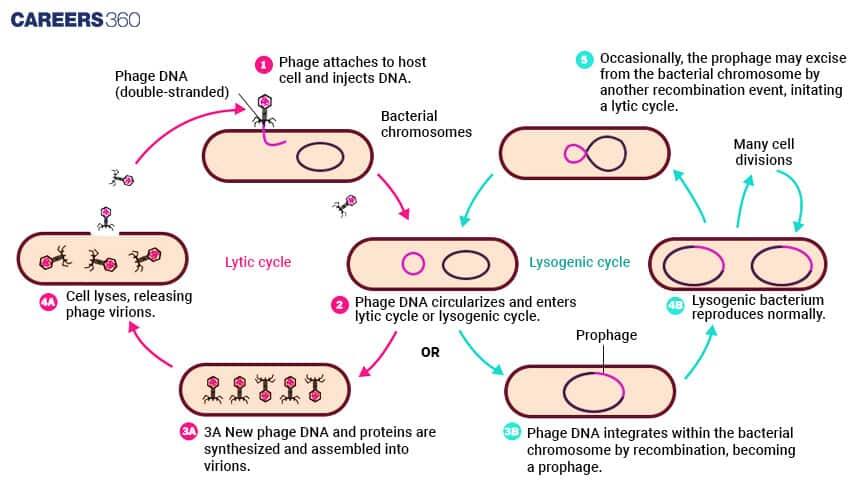Virus: Types, Characteristics, Facts, Topics, Structure
A virus is a microscopic infectious agent that can only replicate inside the living cells of a host organism. They are composed of genetic material (DNA or RNA) enclosed in a protein coat. Viruses lack cellular structure and metabolism, making them dependent on host cells for reproduction. They are found in almost every ecosystem on Earth and are the most numerous type of biological entity.
This Story also Contains
- What is a Virus?
- Virus Structure and Composition
- Virus Diagram
- Classification of Viruses
- Viral Life Cycle
- Economic Importance of Viruses
- Impact Of Viruses On Health
- Preventive Measures
- Recommended video for Virus
.jpg)
Some viruses may have evolved from plasmids, which are pieces of DNA that can move between cells. Other viruses may have evolved from bacteria. This article includes learning about the structure and composition of viruses, virus classification, virus diagrams, and the economic importance of viruses. Virus is a topic of the chapter Biological Classification in Biology.
What is a Virus?
Viruses are submicroscopic infectious agents consisting of nucleic acids, which are either DNA or RNA, surrounded by a protein shell. It does not have a cellular organization and can only reproduce itself in living host cells, where it exploits host cell resources. In general, viruses have been known since the end of the 19th century, considering the facts reflecting the existence of viruses during diseases such as the tobacco mosaic virus.
Viruses are disease agents that significantly attack plants, animals, and human beings, including the flu and other infectious diseases such as COVID-19. Furthermore, the knowledge of viruses has contributed to the enhancement of disciplines such as molecular biology and Immunology through boosting the research in antiviral vaccines and cures that may reduce the effects of viral infections on the health of the world.
Commonly Asked Questions
Virus Structure and Composition
Viruses are simple infectious agents composed of genetic material enclosed in a protective protein coat, and sometimes a lipid envelope. The structure and composition of viruses are discussed below-
General Structure
Viruses contain the genetic material, DNA or RNA, surrounded by a protein shell known as the capsid, and is made up of capsomeres. Some viruses also have an outer lipid coat known as an envelope that is derived from the host cell membrane and hosts the viral glycoproteins on it.
Capsid And Capsomeres
The capsid is composed of capsomeres made up of proteins that enclose and safeguard the viral nucleic acid. Capsomeres are the pin particles and they self-assemble to form the capsid lattice.
Genetic Material (DNA Or RNA)
Viruses have the genetic material in the form of DNA or RNA with the necessary information on how the virus is to replicate and also assemble. This genetic material may be in the form of single-stranded or double-stranded depending on the virus type.
Envelope (In Some Viruses)
While being a part of the viral particle construction, certain viruses are enveloped. This envelope is an acquired lipid bilayer that has its origin in the host’s cell membrane – it contains viral glycoproteins that play the role of host-recognition proteins as well as being involved in the entry of viral particles into the host cell.
Also Read:
Commonly Asked Questions
Virus Diagram

Classification of Viruses
Viruses are very small organisms that can infect living things like plants, animals, and humans. They come in many different types. Scientists classify viruses based on where they live, what kind of genetic material they have, how they look, and how they spread. The classification of viruses is listed below
Based on Host
The types of viruses based on the host are
Type of Virus | Host | Description | Example |
Bacteriophages | Bacteria | These viruses infect bacteria and help in science and medicine. | T4 phage |
Plant Viruses | Plant | These viruses infect plants and damage leaves or stop growth. | Tobacco mosaic virus |
Animal Viruses | Animal | These viruses infect animals and make them sick. | Flu virus, HIV |
Based on Genetic Material
The types of viruses based on genetic material are
Type of Virus | Genetic Material | Function | Example |
DNA Viruses | DNA | Use DNA to make more viruses inside the host cell. | Herpes virus |
RNA Viruses | RNA | Use RNA to make copies with the help of special enzymes. | Influenza virus |
Retroviruses | RNA | Convert RNA into DNA and insert it into the host's DNA. | HIV (AIDS virus) |
Based on the Structure
The type of viruses based on structure of caspid are
Type of Virus | Structure | Description | Example |
Helical Viruses | Spiral (helix) | Have a spiral-shaped body made of RNA/DNA and a protein coat (capsid). | Tobacco mosaic virus (TMV) |
Icosahedral Viruses | 20-sided shape (like a ball) | It has a round shape with 20 triangular faces and a protein shell. | Adenovirus |
Complex Viruses | A complicated shape with a tail | Have a head, tail, and other parts | T4 Bacteriophage |
Based on the Virus's Site of Replication
The types of viruses based on the replication site are
Virus Type | Site of replication | Example |
Cytoplasmic Viruses | In the cytoplasm of host cells | Poliovirus |
Nuclear Replicating Viruses | In the nucleus of host cells | Adenovirus |
Complex Replication Cycle | In both the nucleus and the cytoplasm | Retroviruses like HIV |
Based on the Mode of Transmission
The types of viruses based on the mode of transmission are
Type of Virus | Mode of Transmission | Examples |
Respiratory Viruses | Spread through the air when people cough, sneeze, or talk | Influenza, SARS-CoV-2 |
Fecal-Oral Viruses | Spread by eating food or drinking water with infected stool | Hepatitis A |
Vector-Borne Viruses | Spread through insect bites (mosquito, tick, etc.) | Dengue |
Direct Contact Viruses | Spread by touching an infected person or their things | Herpes simplex (HSV-1 & 2) |
Sexually Transmitted | Spread through sexual contact (vaginal, anal, oral) | HIV, HSV |
Blood-Borne Viruses | Spread through infected blood or blood products | Hepatitis B, Hepatitis C |
Commonly Asked Questions
Viral Life Cycle
Viruses are tiny infectious agents that cannot reproduce on their own. They need a host cell (like a human or animal cell) to survive and multiply. The viral life cycle is listed below-
Stages of Viral Replication:
Attachment
A viral particle binds to a specific receptor on the outer membrane of a permissive host cell. This binding is generally very selective and dictates the host range of the virus.
Penetration
The virus gets into the host cell through a process of virus penetration where the virus envelope breaks and releases the particle into the host cell/ or through endocytosis which is a process where the virus gets into a vesicle and the envelope of the virus fuses with the vesicle to release the viral genome into the host cell or cytoplasm.
Uncoating
The viral nucleic acid is liberated from being enclosed within its protein shell (capsid) or an envelope. This step can be an enzymatic activity, altering the pH within the cell, that brings out the viral genome for replication.
Replication
Replication of the viral genome takes place using the host cell’s facilities. Such steps may include converting viral genes to make viral mRNA, which in turn is used to form viral proteins. Depending on the type of RNA virus, the RNA can be directly linked to proteins or play the role of an RNA template in RNA replication.
Assembly
Viral components, which have been newly synthesised, including capsid proteins, viral RNA or DNA, and viral enzymes, are put together to form new viral particles called virions within the host cell. This process usually transpires in restricted locations of the cell, for instance, the nucleus, cytoplasm, or cellular membranes.
Release
New virions are made from the host cell to go on and infect other cells and go on to the next phase of the virus life cycle. Release can be through lysis, simply causing the cell membrane to burst and release the virions, or through budding, where the virions are released from the cell membrane but the cell is not killed and continues to produce viruses.
Lytic Cycle

Lysogenic Cycle

Commonly Asked Questions
Economic Importance of Viruses
Viruses immensely impact the economy positively and negatively. They are crucial in biotechnology and genetic engineering for the manufacturing of vaccines and methods of protecting crops through vectors. However, major diseases in agriculture and livestock resulting from viral infections lead to crop failures and decreased productivity in crops, leading to global food insecurity and the distortion of economies. Human viral epidemics, for example, have resulted in tremendous health-related burdens and economic disturbances, such as influenza and COVID-19.
Impact Of Viruses On Health
Viruses can cause a wide range of illnesses in humans, from mild infections like the common cold to serious diseases like AIDS and COVID-19. The impact of viruses on health is listed below-
Common Viral Diseases:
Influenza
Responsible for flu episodes during winter with such signs as fever, cough, and aching muscles that result in pneumonia.
HIV/AIDS
Reduces the immune system and hence makes individuals prone to infections and cancers. AIDS can therefore be described as the last stage of Human Immunodeficiency Virus infection, commonly referred to as Acquired Immune Deficiency Syndrome.
COVID-19
It is caused by SARS-CoV-2. Although it causes mild to severe pneumonia and ARDS, it is impacting the world’s health significantly.
Hepatitis
Various viruses, such as A, B, and C, affect the liver to cause inflammation that leads to phenomena such as jaundice, fatigue, and in the chronic stages cirrhosis and liver cancer.
Commonly Asked Questions
Preventive Measures
Preventive measures help stop the spread of viruses and control infections. Methods like vaccination and antiviral drugs are important to reduce illness and protect health.
Vaccination
Vaccines help the body to develop immunity to particular viruses: either by preventing the occurrence of an illness or in case of the virus getting inside the body, minimising its impact. The immunisation campaigns have proven vital in the fight against viral ailments like influenza, measles, and polio among others.
Antiviral Drugs
These medications can affect the virus replication or proteins and decrease its copy in the body or lessen the symptoms. They are employed to provide relief in conditions like influenza, HIV/AIDS, hepatitis and so on to better control the epidemic and to reduce the severity of the illness.
Also Read:
Recommended video for Virus
Frequently Asked Questions (FAQs)